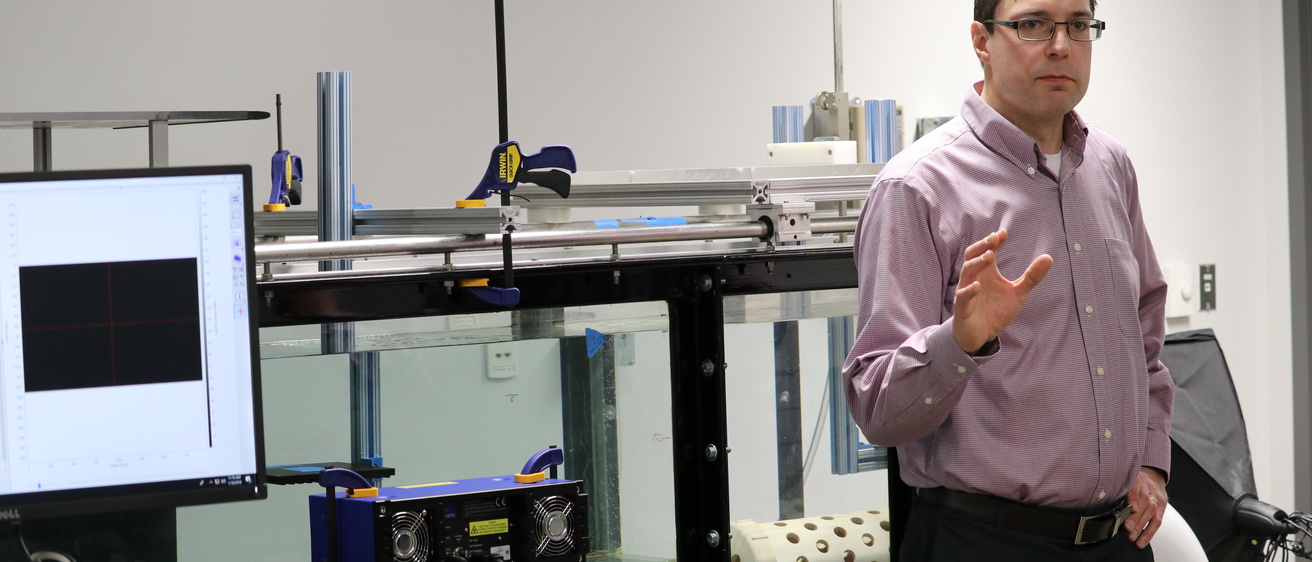On Friday, January 18, the Engineering Fluids Laboratories held an open house to display the new facilities and equipment available to University of Iowa students. Numerous IIHR faculty members were on hand to guide students through the three labs in the suite: the Fluids Fundamentals Lab, Fluids Workshop, and the Advanced Measurements Lab. Undergraduate and graduate students can apply to use the facilities for projects.
IIHR researcher James Buchholz, who oversaw much of the lab’s development, envisions it becoming a hub for students to collaborate and learn from each other.
“One of the things I’m a little bit concerned about in general is that education is becoming more and more expensive,” says Buchholz. “We need ways to improve the quality of our education and try to do it as efficiently as we can. That is why we’re trying to create a learning community around the Fluids Workshop and the Advanced Measurements Lab—so that we can have students who support each other to pursue what excites them and study the topics they’re interested in.”
What’s in the Lab?
The labs, located at 1070 and 1074 in the Seamans Center Annex, boast state-of-the-art equipment including a wind tunnel, towing tank, open-channel flume, “mini-shaker,” a visualization water channel, the Rouse pipe, and a Pelton wheel. Faculty gave several demonstrations of the new laboratory instruments and equipment for onlooking students.
Buchholz also wanted the open house to serve as an opportunity for students to meet members of the Iowa Marine Autonomous Racing Club (IMARC), which he describes as central to forming the new learning community within the lab.
“We have powerful tools, advanced instrumentation, great computational resources, and then we have the students in IMARC,” says Buchholz. “This is a group of students that knows how this lab works, so if a student comes in to use equipment for a project, they’ll have peers they can learn from. Hopefully, they will in turn contribute something back to the community through their research or by helping someone else down the line.”
Grace Edwards, a senior majoring in mechanical engineering, serves as president of IMARC. Edwards was on hand to explain to students what IMARC does and how it uses the fluids lab for research.
“IMARC uses the Fluids Workshop as our home base. We stow all of our equipment here and we use the towing tank to run different fluid calculations,” says Edwards. “Whether it’s buoyancy calculations or testing propeller speeds, we use the computers here to run our software. It’s been great to have a lab like this to work in.”
Buchholz also hopes fellow engineering professors will integrate the fluids labs into courses they teach, giving students more hands-on experience. Ben Clark, a junior majoring in mechanical engineering, is eager to use the lab for that very reason. Clark, who currently takes Biomimetic Fluid Dynamics with Buchholz and plans to join IMARC, is interested in using the towing tank in particular.
“The towing tank really impresses me because it gives students a localized option to do scale modeling, which I think is important considering how useful it is for understanding fluid dynamics. It’s important for gathering data for student projects and understanding turbulent flow,” says Clark.
A grant from the Roy J. Carver Charitable Trust funded the reconstruction and reinstallation of the lab’s experiments and instruments, supporting instruction and student-driven research.
